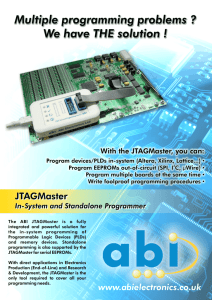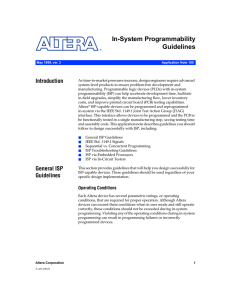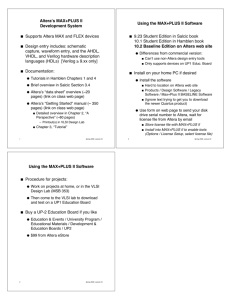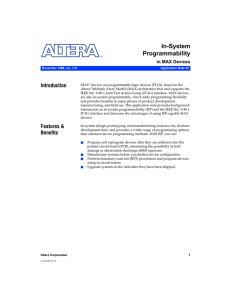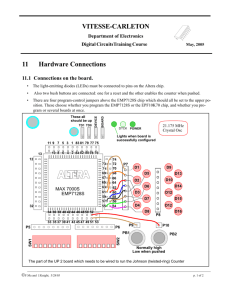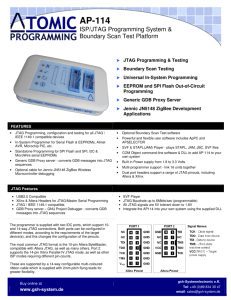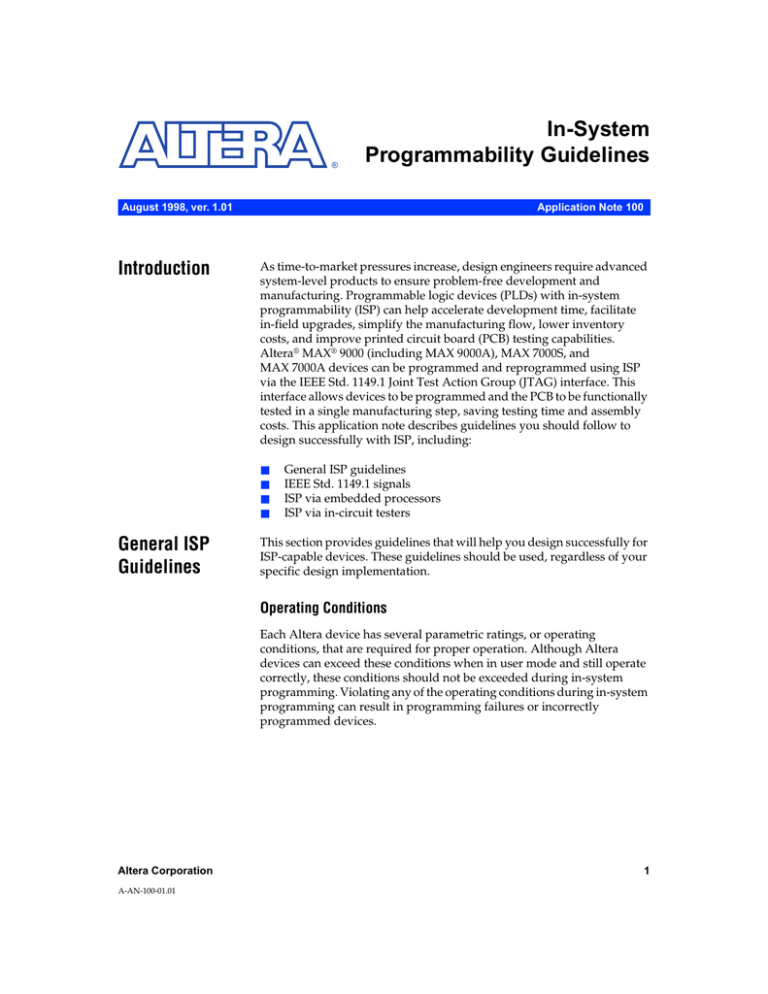
®
In-System
Programmability Guidelines
August 1998, ver. 1.01
Introduction
Application Note 100
As time-to-market pressures increase, design engineers require advanced
system-level products to ensure problem-free development and
manufacturing. Programmable logic devices (PLDs) with in-system
programmability (ISP) can help accelerate development time, facilitate
in-field upgrades, simplify the manufacturing flow, lower inventory
costs, and improve printed circuit board (PCB) testing capabilities.
Altera® MAX® 9000 (including MAX 9000A), MAX 7000S, and
MAX 7000A devices can be programmed and reprogrammed using ISP
via the IEEE Std. 1149.1 Joint Test Action Group (JTAG) interface. This
interface allows devices to be programmed and the PCB to be functionally
tested in a single manufacturing step, saving testing time and assembly
costs. This application note describes guidelines you should follow to
design successfully with ISP, including:
■
■
■
■
General ISP
Guidelines
General ISP guidelines
IEEE Std. 1149.1 signals
ISP via embedded processors
ISP via in-circuit testers
This section provides guidelines that will help you design successfully for
ISP-capable devices. These guidelines should be used, regardless of your
specific design implementation.
Operating Conditions
Each Altera device has several parametric ratings, or operating
conditions, that are required for proper operation. Although Altera
devices can exceed these conditions when in user mode and still operate
correctly, these conditions should not be exceeded during in-system
programming. Violating any of the operating conditions during in-system
programming can result in programming failures or incorrectly
programmed devices.
Altera Corporation
A-AN-100-01.01
1
AN 100: In-System Programmability Guidelines
VCCISP Voltage
All Altera ISP-capable devices have a specification called VCCISP. The
VCCISP level must be maintained on the VCCINT pins during in-system
programming to ensure that the device’s EEPROM cells are programmed
correctly. The VCCISP specification applies for both commercial- and
industrial-temperature-grade devices.
Because power consumption during in-system programming can exceed
the power consumption during user mode, you may need to adjust your
in-system programming setup to maintain correct voltage levels during
both modes. Altera recommends that you test the VCCISP levels on the
device’s VCCINT pins using an oscilloscope. Set the oscilloscope’s trigger
level to 4.75 V and 5.25 V. Then, measure the voltage between VCCINT and
ground, probed at the pins of the device. If the oscilloscope is triggered,
you should adjust your programming setup.
Input Voltages
Each device family data sheet lists device input voltage specifications in
the absolute maximum ratings and recommended operating conditions
tables. The input voltages in the absolute maximum ratings tables refer to
the voltages beyond which the device risks permanent damage. For
example, MAX 9000 devices have a maximum input voltage of 7.0 V and
a minimum input voltage of –2.0 V.
The recommended operating conditions tables specify the voltage range
for safe device operation. All devices can operate safely with input
voltages between (ground – 1 V) and (VCCINT + 1 V), and with input
currents up to 100 mA. Make sure all pins that transition during in-system
programming do not have a ground or VCC overshoot. Overshoot
problems typically occur on free-running clocks or data buses that can
toggle during in-system programming.
f
Go to the Operating Requirements for Altera Devices Data Sheet in the
1998 Data Book for more information.
Interrupting In-System Programming
Altera does not recommend interrupting the programming process
because partially programmed devices have unpredictable operation.
Partially programmed devices also cause signal conflicts, which can lead
to permanent device damage.
2
Altera Corporation
AN 100: In-System Programmability Guidelines
IEEE Std.
1149.1 Signals
This section provides guidelines for programming with the IEEE Std.
1149.1 (JTAG) interface.
TCK Signal
Most in-system programming failures are caused by a noisy TCK signal.
Noisy transitions on rising or falling edges can cause incorrect clocking of
the IEEE Std. 1149.1 Test Access Port (TAP) controller. Incorrect clocking
can cause the state machine to transition to an unknown state, leading to
in-system programming failures.
Further, because the TCK signal must drive all IEEE Std. 1149.1 devices in
the chain in parallel, the signal may have a high fan-out. Like any other
high fan-out user-mode clock, you must manage a clock tree to maintain
signal integrity. Typical errors that result from clock integrity problems
are invalid ID messages, blank-check errors, or verification errors.
Programming via a Download Cable
If you are using the BitBlaster™, ByteBlaster™, or ByteBlasterMV™
download cable and your JTAG chain contains three or more devices,
Altera recommends adding a buffer to the chain. You should select a
buffer with slow transitions to minimize noise.
If you must extend the download cable, you can attach a standard PC
parallel or serial port cable to the download cable. Do not extend the
10-pin header portion of the download cable; extending this portion of the
cable can cause noise and in-system programming problems.
f
Altera Corporation
For more information on the BitBlaster, ByteBlaster, or ByteBlasterMV
download cables, go to the BitBlaster Serial Download Cable Data Sheet,
ByteBlaster Parallel Port Download Cable Data Sheet, or ByteBlasterMV
Parallel Port Download Cable Data Sheet.
3
AN 100: In-System Programmability Guidelines
Disabling IEEE Std. 1149.1 Circuitry
If your design does not use ISP or BST circuitry, Altera recommends
disabling the IEEE Std. 1149.1 circuitry. Table 1 summarizes how to
disable the IEEE Std. 1149.1 circuitry when it is not in use.
Table 1. Disabling IEEE Std. 1149.1 Circuitry
Devices
Permanently Disabled
Enabled for ISP & BST,
Disabled During User Mode
MAX 7000S,
In the MAX+PLUS® II software, Either pull TMS high and TCK
MAX 7000A, (1) turn off the Enable JTAG
low, or pull TMS high before
Support option.
pulling TCK high.
MAX 9000,
MAX 9000A
Either pull TMS high and TCK
low, or pull TMS high before
pulling TCK high.
Either pull TMS high and TCK
low, or pull TMS high before
pulling TCK high.
Note:
(1)
Information on MAX 7000A devices is preliminary.
JTAG Permanently Disabled (MAX 7000S & MAX 7000A Devices)
MAX 7000S and MAX 7000A device JTAG pins can be used as either JTAG
ports or I/O pins. You should specify how the pins will be used before
compiling your design in the MAX+PLUS II software by turning the
Enable JTAG Support option on or off. When the Enable JTAG Support
option is turned on, the pins act as JTAG ports for in-system
programming and boundary-scan testing; when the Enable JTAG Support
option is turned off, the pins act as I/O pins and you cannot perform
in-system programming or boundary-scan testing.
f
For more information on how to disable the JTAG circuitry using the
MAX+PLUS II software, search for “Classic & MAX Global Project Device
Options Dialog Box” or “Classic & MAX Individual Device Options
Dialog Box” in MAX+PLUS II Help.
JTAG Permanently Disabled (MAX 9000 & MAX 9000A Devices)
JTAG is always enabled in MAX 9000 devices because they have
dedicated JTAG pins and circuitry. Therefore, if you do not plan to use the
ISP and BST circuitry, you can disable the circuitry through the JTAG
pins. To disable JTAG, the JTAG specification instructs you to pull TMS
high but does not explain what to do with TCK. Altera recommends
pulling TMS high and TCK low. Pulling TCK low ensures that a rising edge
does not occur on TCK during the power-up sequence.
4
Altera Corporation
AN 100: In-System Programmability Guidelines
You can pull TCK high, but you must first pull TMS high before you pull
TCK high. Pulling TMS high first ensures that the rising edge or edges on
TCK do not cause the JTAG state machine to leave the test-logic-reset state.
JTAG Enabled for ISP/BST & Disabled in User Mode
For MAX 7000S, MAX 7000A, MAX 9000, and MAX 9000A devices that
use JTAG for either in-system programming or boundary-scan testing,
JTAG must be enabled during ISP and BST but disabled at all other times.
You control JTAG operation through the JTAG pins. Like permanently
disabling MAX 9000 devices, either pull TMS high and TCK low, or pull TMS
high before pulling TCK high.
MultiVolt Devices & Power-Up Sequences
For the JTAG circuitry to operate correctly during in-system
programming or boundary-scan testing, all devices in a JTAG chain must
be in the same state. Therefore, in systems with multiple power supply
voltages, the JTAG pins must be held in the test-logic-reset state until all
devices in the chain are completely powered up. This procedure is
particularly important because systems with multiple power supplies
cannot power all voltage levels simultaneously.
Altera devices with the MultiVolt™ feature can use two power supply
voltages: VCCINT and VCCIO. VCCINT provides power to the JTAG
circuitry; VCCIO provides power to output drivers for all pins, including
TDO. Therefore, when these devices use two power supply voltages, the
JTAG circuitry must be held in the test-logic-reset state until both power
supplies are turned on. If the JTAG pins are not held in the test-logic-reset
state, in-system programming errors can occur.
VCCINT Powered before VCCIO
If VCCINT is powered up before VCCIO, the JTAG circuitry is active but
unable to drive signals out. Thus, any transition on TCK can cause the state
machine to transition to an unknown JTAG state. If TMS and TCK are
connected to VCCIO and VCCIO is not powered up, the JTAG signals are
left floating. These floating values can cause the device to transition to
unintended JTAG states, leading to incorrect operation when VCCIO is
finally powered up. Therefore, all JTAG signals must be disabled as
described in “Disabling IEEE Std. 1149.1 Circuitry” on page 4.
Altera Corporation
5
AN 100: In-System Programmability Guidelines
VCCIO Powered before VCCINT
If VCCIO is powered up before VCCINT, the JTAG circuitry is not active but
TDO is tri-stated. Even though the JTAG circuitry is not active, if the next
device in the JTAG chain is powered up (i.e., a full 3.3-V device powered
by VCCIO), the next device’s JTAG circuitry must stay in the test-logicreset state. Because all TMS and TCK signals are common, they must be
disabled for all devices in the chain. Therefore, the JTAG pins must be
disabled by pulling TCK low.
I/O Pins Tri-Stated during In-System Programming
All device I/O pins are tri-stated during in-system programming. In
addition, MAX 7000S and MAX 7000A devices have a weak pull-up
resistor. The value of this pull-up resistor is listed in the MAX 7000
Programmable Logic Device Family Data Sheet and the MAX 7000A
Programmable Logic Device Family Data Sheet, respectively.
You must add sufficient pull-up or pull-down resistors on signals
requiring a particular value during in-system programming (e.g., output
enable or chip enable signals). If a pull-up or pull-down resistor is not
added, the device will have high current during in-system programming
(caused by conflicts on the board), in-system programming failures with
either unrecognized device or verify errors, or a power-up after in-system
programming fails.
Invalid ID & Unrecognized Device Messages
The first step during in-system programming is to check the device’s
silicon ID. If the silicon ID does not match, an Invalid ID or
Unrecognized Device error is generated. Typical causes for this error
are shown below:
■
■
■
■
■
6
Incorrectly connected download cable
TDO is not connected
Incomplete JTAG chain
Noisy TCK signal
Jam™ Player ported incorrectly
Altera Corporation
AN 100: In-System Programmability Guidelines
Incorrectly Connected Download Cable
You will receive an error if the download cable is connected incorrectly to
the parallel port or if it is not receiving power from your board.
f
For more information on installing the BitBlaster, ByteBlaster, or
ByteBlasterMV download cable, go to the BitBlaster Serial Download Cable
Data Sheet, ByteBlaster Parallel Port Download Cable Data Sheet, or
ByteBlasterMV Parallel Port Download Cable Data Sheet.
TDO Is Not Connected
You will receive an error if the TDO port is not connected. The TDO port
must be connected for the device(s) to program successfully.
Incomplete JTAG Chain
You will receive an error if the JTAG chain is not complete. To check if an
incomplete JTAG chain is causing the error, use an oscilloscope to watch
vectors coming out of each device in the chain. If each device’s TDO port
does not toggle during in-system programming, your JTAG chain is not
complete.
Noisy TCK Signal
Noise on the TCK signal is the most common reason for in-system
programming errors. Noisy transitions on rising or falling edges can
cause incorrect clocking of the IEEE Std. 1149.1 TAP controller, causing
the state machine to be lost and in-system programming to fail.
Jam Player Ported Incorrectly
You will receive an error if the Jam Player was not ported correctly for
your platform. To check if the Jam Player is causing the error, apply the
IDCODE instruction to the target device through a Jam File (.jam) or Serial
Vector Format File (.svf). You can use a Jam File or SVF File to load an
IDCODE instruction and then shift out the IDCODE value. This test
determines if the JTAG chain is set up correctly and if you can read and
write to the JTAG chain properly. Figure 1 shows a sample Jam File for
reading the IDCODE.
Altera Corporation
7
AN 100: In-System Programmability Guidelines
Figure 1. Sample Jam File for Reading the IDCODE
'This example reads the IDCODE for the second device in the chain below:
'TDI -> EPM7128S -> EPM7064S -> EPM7256S -> EPM7256S -> TDO
'The device IDCODE can be found in AN 39: IEEE 1149.1 (JTAG) Boundary-Scan Testing
'in Altera Devices
BOOLEAN expected_data[32] = BIN 10111011000000100110000011100000;
'EPM7064S IDCODE
PREIR 20;
' This command bypasses the 2 devices after EPM7064S
POSTIR 10;
' This command bypasses the 1st device
PREDR 2;
' This command bypasses the 2 devices after EPM7064S
POSTDR 1;
' This command bypasses the 1st device
STATE RESET;
IRSCAN 10, 057;
DRSCAN 32, FFFFFFFF COMPARE expected_data[0..31], FFFFFFFF, error;
IF error==0 then PRINT "IDCODE read successfully";
IF error==1 then PRINT "IDCODE not read successfully";
Figure 2 shows a sample SVF File for reading the IDCODE. When a device
is part of a larger chain, you must add appropriate header and trailer
information to the file.
Figure 2. Sample SVF File for Reading the IDCODE
! If the device is in a chain of devices, HIR, HDR, TIR, and TDR
! statements must be added here.
STATE RESET;
SIR 10 TDI (057);
SDR 32 TDI (FFFFFFFF) TDO (<add appropriate IDCODE here>) MASK (FFFFFFFF);
! If the IDCODE is wrong, the previous line gives compare errors when executed
These sample files can be extended to implement more error checking
when the IDCODE instruction is read out of the device. Contact the ISP
Support Program at ISPembed@altera.com or ISPATE@altera.com for
extended versions of these files. In addition, the readme.txt file that
accompanies the Jam Player source code provides further information on
porting the Jam Player software.
8
Altera Corporation
AN 100: In-System Programmability Guidelines
ISP via
Embedded
Processors
This section provides guidelines for programming ISP-capable devices
using the Jam programming and test language and an embedded
processor.
Processor & Memory Requirements
The Bytecode Jam Player supports 8-bit and higher processors; the ASCII
Jam Player supports 16-bit and higher processors. The Jam Player uses
memory in a predictable manner, which simplifies in-field upgrades by
confining updates to the Jam File. The Jam Player memory uses both ROM
and dynamic memory (RAM). ROM is used to store the Jam Player binary
and the Jam File; dynamic memory is used when the Jam Player is called.
f
For information on how to estimate the maximum amount of RAM and
ROM required by the Jam Player, go to Application Note 88 (Using the Jam
Language for ISP via an Embedded Processor).
Porting the Jam Player
The Altera Jam Player (both Bytecode and ASCII versions) works with a
PC parallel port. To port the Jam Player to your processor, you only need
to modify the jamstub.c or jbistub.c file (for the ASCII Jam Player or
Bytecode Jam Player, respectively). All other files should stay the same.
If the Jam Player is ported incorrectly, an Unrecognized Device error is
generated. The most common causes for this error are listed below:
■
■
■
Altera Corporation
After attaching the ByteBlaster or ByteBlasterMV download cable on
your processor, the TDO value may be read in reversed polarity. This
problem occurs if the parallel port registers are read in inverted
polarity. Refer to the readme.txt file on the In-System
Programmability CD-ROM for more detailed information on how to
solve the problem.
Although the TMS and TDI signals are clocked in on the rising edge of
TCK, outputs do not change until the falling edge of TCK. This
situation causes a half TCK clock cycle lag in reading out the values. If
the TDO transition is expected on the rising edge, the data appears to
be offset by one clock.
Altera’s recommended implementation uses registers to synchronize
the output transitions. In addition, some processor data ports use a
register to synchronize the output signals. For example, reading and
writing to the PC’s parallel port is accomplished by reading and
writing to registers. The use of these registers must be taken into
consideration when reading and writing to the JTAG chain. Incorrect
accounting of these registers can cause the values to either lead or lag
the expected value.
9
AN 100: In-System Programmability Guidelines
You can use a test Jam File to determine if the Jam Player is ported
correctly. Figure 3 shows a sample Jam File that helps debug potential
porting problems, including the three issues discussed previously. You
can download this example file from the literature page on Altera’s
world-wide web site at http://www.altera.com.
Figure 3. Sample Jam File For Debugging Porting Problems (Part 1 of 4)
NOTE JAM_VERSION "1.1 ";
NOTE DESIGN "IDCODE.jam version 1.4 4/28/98";
'#############################################################################
'#This Jam File compares the IDCODE read from a JTAG chain with the
'#expected IDCODE. There are 5 parameters that can be set when executing
'#this code.
'#
'#COMP_IDCODE_[device #]=1, for example -dCOMP_IDCODE_9400=1
'#compares the IDCODE with an EPM9400 IDCODE.
'#PRE_IR=[IR_LENGTH] is the length of the instruction registers you want
'#to bypass after the target device. The default is 0, so if your
'#JTAG length is 1, you don't need to enter a value.
'#POST_IR=[IR_LENGTH] is the length of the instruction registers you
'#want to bypass before the target device. The default is 0, so if
'#your JTAG length is 1, you don't need to enter a value.
'#PRE_DR=[DR_LENGTH] is the length of the data registers you want
'#to bypass after the target device. The default is 0, so if your
'#JTAG length is 1, you don't need to enter a value.
'#POST_DR=[DR_LENGTH] is the length of the data registers you want
'#to bypass before the target device. The default is 0, so if your
'#JTAG length is 1, you don't need to enter a value.
'#Example: This example reads the IDCODE out of the second device in the
'#chain below:
'#
'#TDI -> EPM7128S -> EPM7064S -> EPM7256S -> EPM7256S -> TDO
'#
'#In this example, the IDCODE is compared to the EPM7064S IDCODE. If the JTAG
'#chain is set up properly, the IDCODEs should match.
'#
'#
'# C:\> jam -dCOMP_IDCODE_7064S=1 -dPRE_IR=20 -dPOST_IR=10 -dPRE_DR=2
'#-dPOST_DR=1 -p378 IDCODE.jam
'#
'#
'# Example: This example reads the IDCODE of a single device JTAG chain
'# and compares it to an EPM9480 IDCODE:
'#
'# C:\> jam -dCOMP_IDCODE_9480=1 -p378 IDCODE.jam
'#############################################################################
10
Altera Corporation
AN 100: In-System Programmability Guidelines
Figure 3. Sample Jam File For Debugging Porting Problems (Part 2 of 4)
'######################### Initialization ########################
BOOLEAN
BOOLEAN
BOOLEAN
BOOLEAN
read_data[32];
I_IDCODE[10] = BIN 1001101000;
I_ONES[10] = BIN 1111111111;
ONES_DATA[32]= HEX FFFFFFFF;
BOOLEAN
BOOLEAN
BOOLEAN
BOOLEAN
BOOLEAN
BOOLEAN
BOOLEAN
BOOLEAN
BOOLEAN
BOOLEAN
BOOLEAN
BOOLEAN
BOOLEAN
BOOLEAN
BOOLEAN
BOOLEAN
BOOLEAN
BOOLEAN
BOOLEAN
BOOLEAN
BOOLEAN
BOOLEAN
BOOLEAN
BOOLEAN
ID_9320[32]
= BIN 10111011000000000100110010010000;
ID_9400[32]
= BIN 10111011000000000000001010010000;
ID_9480[32]
= BIN 10111011000000000001001010010000;
ID_9560[32]
= BIN 10111011000000000110101010010000;
ID_7032S[32] = BIN 10111011000001001100000011100000;
ID_7064S[32] = BIN 10111011000000100110000011100000;
ID_7128S[32] = BIN 10111011000000010100100011100000;
ID_7128A[32] = BIN 10111011000000010100100011100000;
ID_7160S[32] = BIN 10111011000000000110100011100000;
ID_7192S[32] = BIN 10111011000001001001100011100000;
ID_7256S[32] = BIN 10111011000001101010010011100000;
ID_7256A[32] = BIN 10111011000001101010010011100000;
COMP_9320_IDCODE =0;
COMP_9400_IDCODE =0;
COMP_9480_IDCODE =0;
COMP_9560_IDCODE =0;
COMP_7032S_IDCODE =0;
COMP_7064S_IDCODE =0;
COMP_7128S_IDCODE =0;
COMP_7128A_IDCODE =0;
COMP_7160S_IDCODE =0;
COMP_7192S_IDCODE =0;
COMP_7256S_IDCODE =0;
COMP_7256A_IDCODE =0;
INTEGER
INTEGER
INTEGER
INTEGER
PRE_IR
PRE_DR
POST_IR
POST_DR
BOOLEAN
BOOLEAN
BOOLEAN
BOOLEAN
SET_ID_EXPECTED[32];
COMPARE_FLAG1 = 0;
COMPARE_FLAG2 = 0;
COMPARE_FLAG
= 0;
=
=
=
=
0;
0;
0;
0;
' This is what is expected to be shifted out of the instruction register
BOOLEAN expected_data[10] = BIN 0101010101;
Altera Corporation
11
AN 100: In-System Programmability Guidelines
Figure 3. Sample Jam File For Debugging Porting Problems (Part 3 of 4)
BOOLEAN ir_data[10];
' These values default to 0, so if you have a single device JTAG chain, you do
' not have to set these values.
PREIR PRE_IR;
POSTIR POST_IR;
PREDR PRE_DR;
POSTDR POST_DR;
INTEGER i;
' ######################### Determine Action ########################
LET COMPARE_FLAG1= COMP_9320_IDCODE || COMP_9400_IDCODE || COMP_9480_IDCODE ||
COMP_9560_IDCODE || COMP_7032S_IDCODE || COMP_7064S_IDCODE;
LET COMPARE_FLAG2 = COMP_7128S_IDCODE || COMP_7128A_IDCODE || COMP_7160S_IDCODE
|| COMP_7192S_IDCODE || COMP_7256S_IDCODE || COMP_7256A_IDCODE;
LET COMPARE_FLAG = COMPARE_FLAG1 || COMPARE_FLAG2;
IF COMPARE_FLAG!= 1 THEN GOTO NO_OP;
FOR i=0 to 31;
IF COMP_9320_IDCODE == 1 THEN LET SET_ID_EXPECTED[i] = ID_9320[i];
IF COMP_9400_IDCODE == 1 THEN LET SET_ID_EXPECTED[i] = ID_9400[i];
IF COMP_9480_IDCODE == 1 THEN LET SET_ID_EXPECTED[i] = ID_9480[i];
IF COMP_9560_IDCODE == 1 THEN LET SET_ID_EXPECTED[i] = ID_9560[i];
IF COMP_7032S_IDCODE == 1 THEN LET SET_ID_EXPECTED[i] = ID_7032S[i];
IF COMP_7064S_IDCODE == 1 THEN LET SET_ID_EXPECTED[i] = ID_7064S[i];
IF COMP_7128S_IDCODE == 1 THEN LET SET_ID_EXPECTED[i] = ID_7128S[i];
IF COMP_7128A_IDCODE == 1 THEN LET SET_ID_EXPECTED[i] = ID_7128A[i];
IF COMP_7160S_IDCODE == 1 THEN LET SET_ID_EXPECTED[i] = ID_7160S[i];
IF COMP_7192S_IDCODE == 1 THEN LET SET_ID_EXPECTED[i] = ID_7192S[i];
IF COMP_7256S_IDCODE == 1 THEN LET SET_ID_EXPECTED[i] = ID_7256S[i];
IF COMP_7256A_IDCODE == 1 THEN LET SET_ID_EXPECTED[i] = ID_7256A[i];
NEXT I;
' ######################### Actual Loading ########################
IRSTOP IRPAUSE;
STATE RESET;
IRSCAN 10, I_IDCODE[0..9], CAPTURE ir_data[0..9];
STATE IDLE;
12
Altera Corporation
AN 100: In-System Programmability Guidelines
Figure 3. Sample Jam File For Debugging Porting Problems (Part 4 of 4)
DRSCAN 32, ONES_DATA[0..31], CAPTURE read_data[0..31];
' ######################### Printing ########################
PRINT "EXPECTED IRSCAN : 1010101010";
PRINT "ACTUAL IRSCAN: ",ir_data[0], ir_data[1], ir_data[2], ir_data[3],
ir_data[4], ir_data[5], ir_data[6], ir_data[7], ir_data[8], ir_data[9];
PRINT "";PRINT "EXPECTED IDCODE : ", SET_ID_EXPECTED[0], SET_ID_EXPECTED[1],
SET_ID_EXPECTED[2], SET_ID_EXPECTED[3], SET_ID_EXPECTED[4],
SET_ID_EXPECTED[5], SET_ID_EXPECTED[6], SET_ID_EXPECTED[7],
SET_ID_EXPECTED[8], SET_ID_EXPECTED[9], SET_ID_EXPECTED[10],
SET_ID_EXPECTED[11], SET_ID_EXPECTED[12], SET_ID_EXPECTED[13],
SET_ID_EXPECTED[14], SET_ID_EXPECTED[15], SET_ID_EXPECTED[16],
SET_ID_EXPECTED[17], SET_ID_EXPECTED[18], SET_ID_EXPECTED[19],
SET_ID_EXPECTED[20], SET_ID_EXPECTED[21], SET_ID_EXPECTED[22],
SET_ID_EXPECTED[23], SET_ID_EXPECTED[24], SET_ID_EXPECTED[25],
SET_ID_EXPECTED[26], SET_ID_EXPECTED[27], SET_ID_EXPECTED[28],
SET_ID_EXPECTED[29], SET_ID_EXPECTED[30], SET_ID_EXPECTED[31];
PRINT "ACTUAL IDCODE : ", READ_DATA[0], READ_DATA[1], READ_DATA[2],
READ_DATA[3], READ_DATA[4], READ_DATA[5], READ_DATA[6], READ_DATA[7],
READ_DATA[8], READ_DATA[9], READ_DATA[10], READ_DATA[11], READ_DATA[12],
READ_DATA[13], READ_DATA[14], READ_DATA[15], READ_DATA[16], READ_DATA[17],
READ_DATA[18], READ_DATA[19], READ_DATA[20], READ_DATA[21], READ_DATA[22],
READ_DATA[23], READ_DATA[24], READ_DATA[25], READ_DATA[26], READ_DATA[27],
READ_DATA[28], READ_DATA[29], READ_DATA[30], READ_DATA[31];
GOTO END;
' ######################### If no parameters are set ########################
NO_OP: PRINT "jam [-d<var=val>] [-p<port>] [-s<port>] IDCODE.jam";
PRINT "-d : initialize variable to specified value";
PRINT "-p : parallel port number or address <for ByteBlaster>";
PRINT "-s : serial port name <for BitBlaster>";
PRINT " ";
PRINT "Example: To compare IDCODE of the 4th device in a chain of 5 Altera ";
PRINT "devices with EPM7192S IDCODE"; PRINT " ";
PRINT "jam -dCOMP_7192S_IDCODE=1 -dPRE_IR=10 -dPOST_IR=30 -dPRE_DR=1 -dPOST_DR=3
-p378 IDCODE.jam";
PRINT " ";
END:
EXIT 0;
Altera Corporation
13
AN 100: In-System Programmability Guidelines
ISP via
In-Circuit
Testers
This section addresses specific issues associated with programming
ISP-capable devices via in-circuit testers.
Using “F” vs. Non-“F” Devices
MAX devices use either fixed algorithms (“F”), or branching algorithms
(non-“F”). Most in-circuit tester file formats, e.g., SVF, Hewlett-Packard
Pattern Capture Format (.pcf), DTS, and ASC, are “fixed” or
deterministic, which means they can only support one fixed algorithm
without branching. The MAX+PLUS II software version 8.2 and higher
generates SVF Files for “F” devices. Because the algorithms in SVF Files
are constant, you can always use these SVF Files to program future “F”
devices.
Altera does not recommend programming non-“F” devices via in-circuit
testers. Non-“F” devices require branching based on three variables read
from the device: programming pulse time, erase pulse time, and
manufacturer silicon ID. These three variables are programmed into all
Altera non-“F” devices. Using only “F” devices eliminates problems you
may experience if these variables change.
Maximum Vectors per File
The file formats for “bed of nails” in-circuit testers generally require very
large vector files for in-system programming. When the file is larger than
the tester’s available memory, the file must be divided into smaller files.
For example, Altera’s svf2pcf utility automatically divides a single SVF
File into several smaller files. In addition, the utility allows users to either
specify the maximum number of vectors per file or use a default value. If
you put too many vectors in a single file, an error message occurs. If you
receive this error, simply reduce the number of vectors per file.
HP 3070 Tester
Altera’s svf2pcf utility automatically divides an HP PCF file into multiple
small files so the HP tester’s memory can support the number of vectors
required for in-system programming.
A small delay occurs when the tester applies each vector file to the device.
During this interval, the HP tester tri-states all pins, briefly drives all pins
low, and then drives the first vector in the subsequent PCF file.
14
Altera Corporation
AN 100: In-System Programmability Guidelines
To avoid unintentional TCK transitions during this interval, you should
follow the two steps shown below:
■
Each PCF vector file must start and end with all signals low. Altera’s
svf2pcf utility performs this function automatically.
■
You must add a pull-down resistor to the TCK signal. This resistor
should be designed into the board to comply with the
recommendation outlined in “JTAG Enabled for ISP/BST & Disabled
in User Mode” on page 5. If the resistor is not designed into the board,
it can be added to the test fixture. The value of this pull-down resistor
is dependent on the number and load of each device in the chain. A
good rule of thumb is 1 kΩ to 5 kΩ if the pull-down resistor is located
on the board and 500 Ω to 1 kΩ if it is located in the test fixture.
Summary
The information provided in this document is based on development
experiences and customer issues resolved by Altera. For more
information on resolving in-system programming problems, contact the
ISP Support Program at ISPembed@altera.com or ISPATE@altera.com.
You can receive information on the Altera ISP Support Program by
visiting the Altera web site at http://www.altera.com.
Revision
History
The information contained in Application Note 100 (In-System
Programmability Guidelines) version 1.01 supersedes information
published in Application Note 100 (In-System Programmability Guidelines)
version 1.0.
Application Note 100 (In-System Programmability Guidelines) version 1.01
contains corrected information on how to disable the IEEE Std. 1149.1
circuitry in Table 1 on page 4.
Altera Corporation
15
AN 100: In-System Programmability Guidelines
®
101 Innovation Drive
San Jose, CA 95134
(408) 544-7000
http://www.altera.com
Applications Hotline:
(800) 800-EPLD
Customer Marketing:
(408) 544-7104
Literature Services:
(888) 3-ALTERA
lit_req@altera.com
16
Altera, MAX, MAX+PLUS, MAX+PLUS II, MAX 9000, MAX 9000A, MAX 7000S, MAX 7000A, BitBlaster,
ByteBlaster, ByteBlasterMV, EPM7128S, EPM7256S, EPM7064S, EPM9400, EPM9480, and Jam are trademarks
and/or service marks of Altera Corporation in the United States and other countries. Altera acknowledges the
trademarks of other organizations for their respective products or services mentioned in this document. Altera
products are protected under numerous U.S. and foreign patents and pending applications, maskwork rights,
and copyrights. Altera warrants performance of its semiconductor products to current specifications in
accordance with Altera’s standard warranty, but reserves the right to make changes to any products and
services at any time without notice. Altera assumes no responsibility or liability arising out
of the application or use of any information, product, or service described herein except as
expressly agreed to in writing by Altera Corporation. Altera customers are advised to
obtain the latest version of device specifications before relying on any published
information and before placing orders for products or services.
Copyright 1998 Altera Corporation. All rights reserved.
Altera Corporation
Printed on Recycled Paper.

